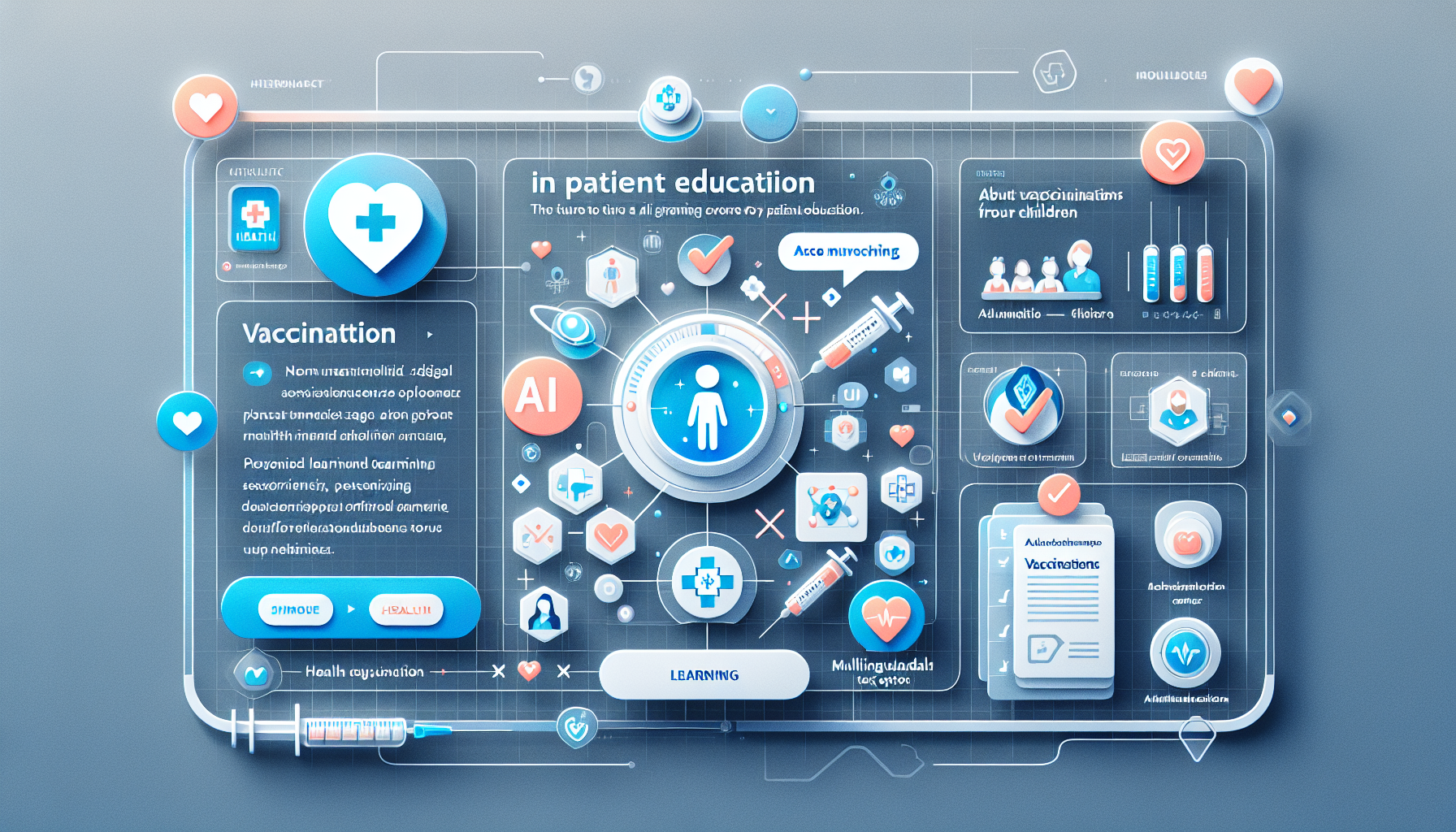Creating effective patient education materials can feel overwhelming, right? With the complexities of medical jargon and the challenge of tailoring information to diverse patient needs, it’s easy to understand why many feel stuck. You’re not alone in this!
But what if I told you there’s a way to simplify the process? By using ChatGPT and well-crafted prompts, you can produce clear, engaging materials that resonate with your patients. Stick with me, and you’ll discover some practical strategies to make your life a whole lot easier.
We’ll explore how to create engaging content with ChatGPT, share example prompts for different health topics, and provide tips for customizing outputs. Plus, I’ll highlight best practices to ensure your materials truly connect with patients. Let’s dive in!
Key Takeaways
Key Takeaways
- Use ChatGPT to create clear, engaging patient education materials by crafting specific prompts tailored to health topics.
- Customize your prompts based on patient demographics, such as age and health literacy, for better relevance and understanding.
- Incorporate visual elements like infographics or checklists to enhance patient comprehension and retention.
- Evaluate the quality of generated content by checking for accuracy, cultural sensitivity, and clarity before distribution.
- Avoid common mistakes by steering clear of jargon and ensuring the content is tailored to patients’ specific needs.

Effective ChatGPT Prompts for Creating Patient Education Materials
Creating effective patient education materials is vital for improving healthcare communication.
With ChatGPT, you can generate clear and informative content tailored for patients.
Here’s a list of effective prompts you can use to create patient education materials:
- “Generate a patient education guide on managing diabetes, focusing on diet and lifestyle changes.”
- “Create a simple explanation of hypertension for patients, including causes, symptoms, and treatment options.”
- “Draft a brochure for patients explaining the benefits of regular exercise and physical therapy.”
- “Give me a list of frequently asked questions about vaccinations and their answers for patient education.”
- “Outline the key points to include in a fact sheet about mental health resources available in the community.”
These prompts can help bolster your healthcare material creation while ensuring clarity and understanding.
How to Use ChatGPT for Developing Clear and Understanding Patient Guides
Using ChatGPT to develop clear patient guides involves a few straightforward steps.
First, define the specific health topic or patient issue you want to address.
Next, craft prompts that clearly outline what information you need.
For instance, you might say: “Create a guide for new parents on recognizing and managing fever in infants.”
Also, ask for summaries after generating a long explanation to ensure clarity.
Remember to request content that aligns with the health literacy level of your audience.
To enhance understanding, consider using prompts like: “Explain the importance of mental health in simple terms for teenagers.”
Examples of ChatGPT Prompts for Various Health Topics
When discussing health topics, specific prompts can lead to insightful and relevant content.
Here’s a collection of ChatGPT prompts tailored for various health topics:
- “Develop a detailed patient guide on heart disease prevention.”
- “Write an informative article about the symptoms and treatment of asthma for patients.”
- “List the stages of chronic kidney disease, including tips for patients in each stage.”
- “Create a glossary of terms related to breast cancer for better patient comprehension.”
- “Generate a checklist for patients preparing for a colonoscopy.”
These prompts can greatly assist healthcare providers in producing tailored resources for their patients.
Tips for Customizing ChatGPT Prompts for Specific Patient Needs
Customizing your ChatGPT prompts effectively can enhance patient-centered care and ensure relevance.
Start by considering the unique needs of your patient population. Are they elderly, children, or perhaps non-native speakers?
Next, tailor your prompts accordingly. For instance, use: “Create a simplified brochure on osteoporosis prevention for senior citizens.”
Utilize culturally sensitive language and examples relevant to the community you’re addressing.
Incorporate specific scenarios that patients may face, like: “Write a guide on managing diabetes for teens with busy schedules.”
Always test your materials for clarity and understanding. It’s key to focus on making the information accessible to all.
For more on healthcare-focused AI applications, check out our post on ChatGPT in Healthcare.

Best Practices for Evaluating the Quality of Generated Patient Education Content
Evaluating the quality of patient education content produced by ChatGPT is essential to ensure accuracy and understanding.
Begin by checking the credibility of the information. Use prompts like: “Review the content on heart disease management for accuracy and reliability.”
Look for clarity and simplicity. Ask ChatGPT: “Simplify this explanation of asthma symptoms to improve patient comprehension.”
Ensure that the content is culturally sensitive and relevant to your specific patient population.
You might say, “Adjust this diabetes management guide for Hispanic patients by including culturally relevant dietary tips.”
Seek feedback from healthcare professionals who can validate the medical accuracy of the information.
For instance, you could prompt: “Get a peer review of this brochure on mental health resources.”
Finally, assess the content’s readability using tools like the Flesch-Kincaid grade level. Use a prompt like: “Generate a readability assessment for this guide on medication adherence.”
By following these best practices, you can ensure that the materials produced are reliable and effective for patient education.
Integrating Feedback to Improve ChatGPT Outputs for Patient Materials
Integrating feedback is a crucial step in improving the quality of patient education materials generated by ChatGPT.
Start by collecting feedback from patients on their understanding of the content. Ask: “What did you find unclear about this brochure on preventive care?”
Incorporate comments from healthcare providers who can offer insights on medical accuracy.
A sample prompt could be: “Revise this patient guide based on the feedback received from my healthcare team.”
Encourage iterative revisions by refining the prompts used to solicit clearer outputs. For example: “Generate a more detailed explanation of arthritis for patients with limited health literacy.”
Consider using surveys or questionnaires to gather systematic feedback on the materials, prompting ChatGPT with: “Create a survey for patient feedback on this educational flyer.”
Lastly, document the changes made based on feedback so you can track improvements over time.
This ongoing process will enhance the effectiveness and relevance of your patient education content.
Utilizing Visual Content Prompts for Enhanced Patient Understanding
Visual content can significantly improve patient understanding and retention of information.
To get started, you can prompt ChatGPT with practical requests like: “Design a simple infographic summarizing key points about the flu vaccination.”
Another helpful prompt could be: “Create a visual checklist for patients preparing for a knee surgery appointment.”
Be specific in your requests to ensure the visuals align with your educational goals. For example: “Generate a flowchart illustrating the steps for managing high blood pressure.”
Encourage multimedia learning by combining text and visuals. You might ask: “Draft a short article on healthy eating and suggest accompanying images or icons to illustrate each point.”
Use prompts such as: “List the best types of visual aids for explaining cardiac rehabilitation to patients.”
Finally, test the effectiveness of your visual aids by asking patients for their feedback. Prompt: “What visuals helped you most in understanding your condition?”
Utilizing visual content will enhance patient engagement and comprehension significantly.
Common Mistakes to Avoid When Using ChatGPT for Patient Education
Using ChatGPT for patient education can be beneficial, but there are common pitfalls to avoid.
First, don’t overlook the importance of accuracy. A prompt like: “Provide an evidence-based explanation of hypertension symptoms” can help ensure correctness.
Be cautious with jargon. Avoid using complex medical terms. Instead, ask: “Explain diabetes in simple language that anyone can understand.”
Another mistake is failing to tailor content to specific patient demographics. You might say: “Create a senior-friendly guide to managing arthritis.”
Don’t forget to review the content for bias or cultural insensitivity. A pertinent prompt could be: “Assess the cultural appropriateness of this cancer awareness flyer.”
Finally, neglecting to gather patient feedback can lead to ineffective materials. Ask: “What are the main areas of confusion in this patient education handout?”
Steering clear of these mistakes will help produce clearer and more effective patient education resources.

Future Trends in AI and Patient Education Content Development
The future of AI in patient education is bright and filled with possibilities that can significantly enhance how patients receive information.
We are likely to see the integration of personalized learning experiences tailored to individual patient needs.
Imagine prompts like: “Create an interactive quiz for patients to assess their understanding of heart health.”
AI can facilitate real-time updates to patient materials based on new research findings or feedback.
For instance, prompt ChatGPT: “Generate an updated guideline on diabetes management that reflects the latest research.”
Expect more sophisticated visual aids powered by AI, enhancing comprehension through images or infographics.
Try prompts such as: “Design an engaging infographic on the importance of vaccinations for children.”
Chatbots and virtual assistants will likely emerge even more in healthcare, providing on-demand answers to patient questions.
Use a prompt like: “How to create a chatbot that can answer common questions about mental health?”
Finally, the development of multilingual capabilities would ensure that vital health information is accessible to a wider audience.
Prompt example: “Translate this patient education brochure into Spanish while maintaining health literacy.”
Keeping an eye on these trends will not only improve patient engagement but also ensure that education is both effective and inclusive.
FAQs
To use ChatGPT effectively, provide clear prompts specifying the health topic, intended audience, and desired format. This enhances the relevance and clarity of the generated materials tailored to patient education.
Common mistakes include being vague in prompts, neglecting to specify the difficulties patients may face, and not reviewing the output for accuracy. Always ensure prompts are clear and contextualized for optimal results.
Evaluate the quality by checking for accuracy, clarity, and relevance to the target audience. Also, assess whether the content adheres to medical guidelines and is understandable for the intended patients.
Provide detailed information about the patient demographics, literacy levels, and specific health concerns. Personalize the prompts to address questions or fears patients typically have about their conditions or treatments.
